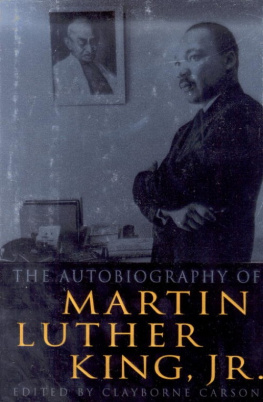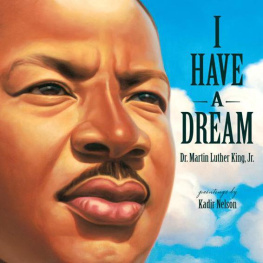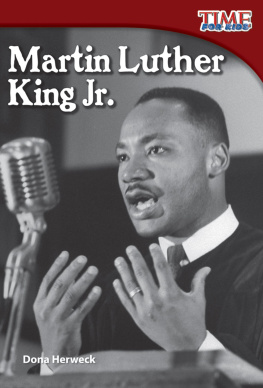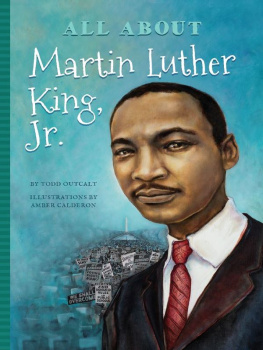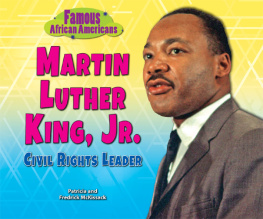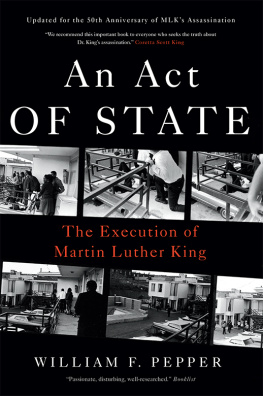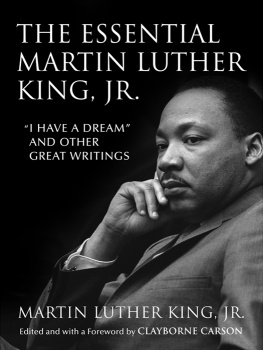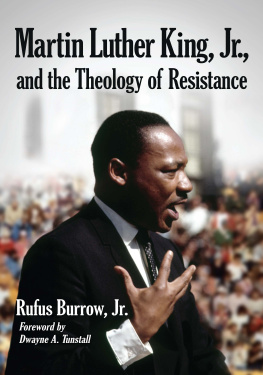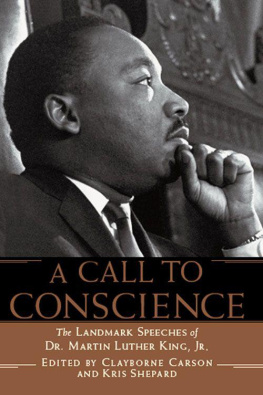THE AUTOBIOGRAPHY OF MARTIN LUTHER KING, JR. Copyright 1998 by The Heirs to the Estate of Martin Luther King, Jr.
All rights reserved. No part of this book may be reproduced in any form or by any electronic or mechanical means,
including information storage and retrieval systems,
without permission in writing from the publisher, except by a reviewer who may quote brief passages in a review.
Warner Books,
Hachette Book Group, USA,
237 Park Avenue, New York,
NY 10017, Visit our Web site at www.HachetteBookGroupUSA.com.
ISBN: 978-0-7595-2037-0
First eBook Edition: January 2001
Second eBook Edition: January 2004
THE AUTOBIOGRAPHY OF
MARTIN LUTHER
KING, JR.
THE AUTOBIOGRAPHY OF
MARTIN LUTHER
KING, JR.
E D I T E D B Y
C L A Y B O R N E C A R S O N
I P M
INTELLECTUAL PROPERTIES MANAGEMENT, INC.
I N A S S O C I A T I O N W I T H

WARNER BOOKS
A Time Warner Company
It gives me great pleasure to finally see my husbands words in autobiographical form. During the Civil Rights Movement a number of publishers and news organizations showed remarkable courage in bringing Martins views to the public. Without these media outlets, the bits and pieces of which this autobiography is made would have been lost to posterity. Hence, my gratitude goes to HarperCollins, William Morrow, Pocket Books, Henry Holt, Pitman, University of California Press, Harper & Row, Random House, New American Library, Kennedy Presidential Library, Albany Herald, Atlanta Journal,Christian Century, Ebony, Hindustan Times, Jet, Look, Massachusetts Review, McCalls, MontgomeryAdviser, Nashville Tennessean, The Nation, New York Amsterdam News, New York Post, New York Times,Playboy, Progressive, Redbook, Saturday Review, Southern Courier, TIME, ABC, BBC, CBC, The MervGriffin Show, NBC, and WAII-TV, as well as others too numerous to mention.
Intellectual Properties Management (IPM) has made extensive efforts to identify the original source of all the material that appears in this autobiography, and to seek appropriate permission. But as with any endeavor, errors can take place. If an oversight is noted, please contact IPM so that proper credit can be made in future editions.
Coretta Scott King, September 1998
CONTENTS
EDITORS PREFACE
I first saw Martin Luther King, Jr., from a distance. He was up on the platform in front of the Lincoln Memorial, the concluding speaker at the 1963 March on Washington for Jobs and Freedom. I was below in the vast crowd of listeners around the reflecting pool, a nineteen-year-old college student attending my first civil rights demonstration. He would become a Man of the Year, a Nobel Prize laureate, and a national icon. I would become a foot soldier in the movement he symbolized and would walk through doors of opportunity made possible by that movement.
More than two decades later, after I became a historian at Stanford University, Mrs. Coretta Scott King unexpectedly called me to offer the opportunity to edit the papers of her late husband. Since accepting her offer to become director of the King Papers Project, I have immersed myself in the documents recording his life and have gradually come to know a man I never met. The study of King has become the central focus of my scholarly life, and this project is the culmination of my career as a documentary editor. The March on Washington started me on the path to The Autobiography of Martin Luther King, Jr. This book is a product of Kings intellectual legacy, just as I am a beneficiary of his social justice legacy.
The following narrative of Kings life is based entirely on his own words. These are his thoughts about the events in his life as he expressed them at different times in various ways. Although he never wrote a comprehensive autobiography, King published three major books as well as numerous articles and essays focusing on specific periods of his life. In addition, many of his speeches, sermons, letters, and unpublished manuscripts provide revealing information. Taken together, these materials provide the basis for this approximation of the autobiography that King might have written had his life not suddenly ended.
For the most part, this book consists of autobiographical writings that were published during Kings lifetime and were personally edited by him. In many instances King was assisted by others, since he made considerable use of collaborators. Nevertheless, Kings papers provide ample evidence of his active involvement in the editorial processes that resulted in his most significant publications. Indeed, the preparation for this autobiography involved examining preliminary drafts (several handwritten) of Kings published writings in order to determine his authorial intentions. I have included passages from such drafts when they contain revealing or clarifying information that does not appear in the published version.
Although Kings published autobiographical writings provide the basic structure of this book, they constitute an incomplete narrative. In order to fill out the narrative and to include Kings accounts of events that are not discussed in his published writings, I have incorporated passages from hundreds of documents and recordings, including many statements that were not intended for publication or even intended as autobiography. These passages augment the published accounts and serve as transitions between more extended narratives. In some instances, I have made editorial changes, which are explained below, in order to construct a narrative that is readable and comprehensible. This exercise of editorial craft is intended to provide readers with a readily accessible assemblage of Kings writings and recorded statements that would otherwise be available only to a handful of King scholars.
I trust that readers will recognize and appreciate the fact that this narrative can never approach the coherence and comprehensiveness that would have been possible if King had been able to write a complete account of his life. Thus, this narrative understates the importance in Kings life of his family. Although King often acknowledged the centrality of his wife, Coretta Scott King, in his public and private life, his extant papers rarely noted the degree to which she participated in protest activities and other public events. Similarly, Kings close ties to his parents, his children, his sister Christine King Farris, and his brother A. D. King are insufficiently reflected in his papers, despite the fact that these relatives played crucial roles in his life.
The Autobiography of Martin Luther King, Jr., is, therefore, largely a religious and political autobiography rather than an exploration of a private life. It is necessarily limited to those aspects of Kings life that he chose to reveal in his papers, but King was never garrulous about his private life and was unlikely to have chosen his autobiography as an opportunity to reveal intimate details of his life. In his personal papers, however, King sometimes overcame his reticence to expose his private feelings to public view. He left behind documents that offer information that has never previously been published and that collectively defines his character. Although King may have selected or utilized these materials differently than I have, he (or researchers and co-authors working with him) would certainly have recognized them as essential starting points for understanding his life.

